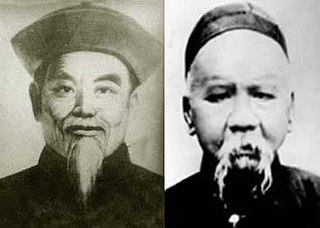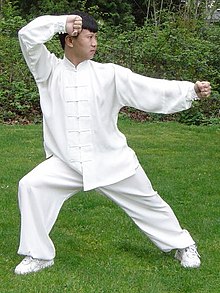
Tai chi is an internal Chinese martial art practiced for self-defense and health. Known for its slow, intentional movements, tai chi has practitioners worldwide and is particularly popular as a form of gentle exercise and moving meditation, with benefits to mental and physical health.

Cheng Man-ch'ing or Zheng Manqing was a Chinese expert of tai chi, Chinese medicine, and the so-called three perfections: calligraphy, painting and poetry. He was born in Yongjia, Zhejiang Province, during the Qing dynasty. Cheng died March 26, 1975; his grave is near the city of Taipei in Taiwan.

Yang Chengfu (1883–1936) was one of the best known teachers of Yang-style tai chi. He helped develop the art into its modern form. His students would go on to found successful martial arts schools of their own and helped spread Yang-style tai chi around the world.

Wu (Hao)-style tai chi is one of the five primary styles of tai chi. It was created in the mid-nineteenth century by Wu Yuxiang, a member of a wealthy and influential family in Yongnian, Hebei, China. Wu trained for approximately ten years with the founder of Yang-style tai chi, and then for over a month with a Chen-style master. Wu also obtained a manual on internal martial arts that formed the core of what are now known as the tai chi classics and include Wu's own writing on the subject. From these sources Wu and his family developed their own style, and may also have developed much of the cultural and intellectual foundation of tai chi as well.

Yang-style tai chi is one of the five primary families of tai chi. Including its variations, it is the most popular and widely practised style of tai chi in the world today. It is second in terms of seniority, after Chen-style tai chi.

Wu Jianquan was a famous teacher and founder of the neijia martial art of Wu-style tai chi in late Imperial and early Republican China.

Wu Gongyi was a well-known teacher of the soft style martial art tai chi in China, and, after 1949, in British Hong Kong. He was also the "gate-keeper" of the Wu family from 1942 until his death in 1970.

Wu Kung-tsao or Wu Gongzao (1902–1983) was a famous Chinese teacher of tai chi. He taught in Beijing, Shanghai, Changsha and Hong Kong. The second son of Wu Jianquan, he was the grandson of the first teacher of Wu-style tai chi, Wu Quanyou. Wu Kung-tsao was the younger brother of Wu Gongyi and the older brother of Wu Yinghua. The Wu family were originally of Manchu ancestry.

Yang Shaohou was a Chinese martial arts master who, along with Yang Chengfu, represents the third generation of Yang-style tai chi. Grandmaster of his generation and known for his compact "small frame" techniques, he was a ferocious fighter and a demanding teacher.

Ma Yueliang or Ma Yueh-liang was a famous Manchu teacher of tai chi. He was the senior disciple of Wu Jianquan, the founder of Wu-style tai chi, and married Wu's daughter Wu Yinghua in 1930.
Chen Weiming (1881–1958) was a scholar, tai chi teacher, and author. He was also known by his name Chen Zengze (陳曾則), Weiming being his hao, a pen-name.

The tai chi classics are a collection of over 100 articles on the Chinese martial art of tai chi written by the art's master practitioners over the centuries. They cover everything from the underlying taiji philosophical principles, to methods of practice and application. Previously passed down in secret from generation to generation in whole or in parts through various lineages, they achieved classical status as they became public starting in the mid-1930s. Together they now serve as the single authoritative guide for the development and usage of tai chi skills. Written mostly in classical Chinese, they are used today mostly by the serious martial art practitioners of modern 6 Lineages that all trace their lineages to the ancient style taught by the Chen family and Yang family starting in the mid-19th century.

Chen Xiaowang is an Australian-Chinese tai chi teacher, who was born and raised in Chen Family Village, Wen County, Henan province, and is the 19th generation lineage holder of Chen-style tai chi. His grandfather was the tai chi grandmaster Chen Fake.

Yang Zhenduo, a native of Yongnian, Hebei, was born in Beijing, China, into the famous Yang family of martial artists. A son of Yang Chengfu and a great-grandson of Yang Luchan, Yang Zhenduo was a fourth-generation descendant of the Yang Family of tai chi, and was the fourth lineage-holder of the style.

The International Yang Style Tai Chi Chuan Association is a non-profit organization dedicated to the teaching, promotion and propagation of the Traditional Yang-style tai chi. It was founded on October 29, 1998 by Grandmaster Yang Zhenduo and his grandson Master Yang Jun. The association is headquartered in Seattle, Washington, United States.

Wudangquan is a class of Chinese martial arts. In contemporary China, Chinese martial arts styles are generally classified into two major groups: Wudang (Wutang), named after the Wudang Mountains; and Shaolin, named after the Shaolin Monastery. Whereas Shaolin includes many martial art styles, Wudangquan includes only a few arts that use the focused mind to control the body. This typically encompasses tai chi, xingyiquan and baguazhang, but must also include bajiquan and Wudang Sword. Although the name Wudang distinguishes the skills, theories and applications of the internal arts from those of the Shaolin styles, these arts did not originate in the Wudang Mountains: the name Wudang comes from a popular Chinese legend that purports the genesis of tai chi and Wudang Sword by an immortal, Taoist hermit named Zhang Sanfeng who lived in the monasteries of Wudang Mountain. Wudang quan is often used synonymously with Neijia, but Neijia is a broader term that also encompasses Aikido and Qigong, which are not Wudang quan.

Dong Yingjie was a leading master of tai chi, and a top disciple of Yang Chengfu. Born in Ren County, Hebei, China, his given name was Wenke (文科). Famous in his time for defeating a foreign boxer in a public challenge match, he dedicated his life to the martial arts, training intensively in multiple styles, serving as chief assistant instructor for Yang Chengfu, and going on to found his own thriving tai chi legacy.

Yang Luchan, also known as Yang Fukui (1799–1872), was an influential Chinese practitioner and teacher of the internal style tai chi. He is known as the founder of Yang-style tai chi, the most popular and widely practised tai chi style in the world today.

Wu-style tai chi is one of the five main styles of tai chi. It is second in popularity after Yang-style, and the fourth-oldest of the five major tai chi styles. It was developed by Wu Quanyou and Wu Jianquan.

Xie Bingcan or Xie Bingshan was a notable expert and teacher of Qigong, Tuina, and tai chi.













